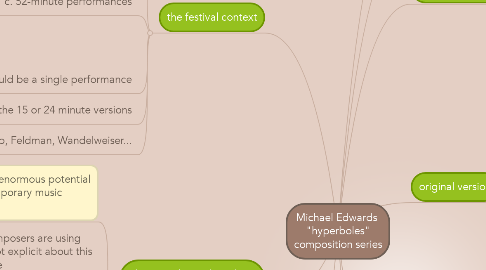
1. what is it?
1.1. a flexible, musician-tweaked algorithmic piece originally written for flute and computer in 2013/14 but since developed and extended for other solo and group instrumental combinations with or without the computer. There is no permanently fixed score as such; rather, a score is generated by the underlying software via configuration of the parameter space presented by a separate software interface.
2. thematises hypertrophied views of artistic creation as the emotional and emotive products of inspired genius
3. contrasts this with a hyperbolic concept of emotionless music.
3.1. interpretation by a human being immediately confounds this, of course
3.2. and highlights all that which human beings bring to notated compositions and other art forms
4. original version
4.1. title
4.1.1. hyperboles are the worst thing ever (aka Epimenides would have been gutted)
4.2. for Anne La Berge
4.2.1. Amsterdam/US
4.3. premiered at Splendor, Amsterdam
4.3.1. June 2014
4.3.2. live recording available
4.4. programme note
4.4.1. Humans exaggerate on a regular basis. Typical hyperboles might be “this bag weighs a ton”, “I’m so hungry I could eat a horse”, or any of the invariably (!) hilarious “Yo’ mama so fat. . . ” jokes. Perhaps even worse than footballers (“I hit the post. I was gutted”) are artists. Have you ever sat silently suffering (“dying”, anyone?) at a contemporary poetry reading, as the reciter over-emotes their way through a litany of subtexts we can summarise by “me, me, me! I’m so deep and clever!”? Such occasions often merely reinforce the popular perception of artistic outputs as being expressive of the creator’s emotions. But that is less interesting than artworks’ invitation to be social, communal, and at the same time to introspect and inspect our personal, perhaps emotional reactions to intrinsically neutral objects: When faced with a Nitsch picture of animal guts resting on a man’s genital area, do we feel horror and offence or see the skin as a mirror, a symmetrical inversion of nothing more than what’s behind the man’s (and by implication our) skin at all times, sobering as that may be (“hello mortality!”)? Whilst on the subject of male genitalia, do Mapplethorpe’s motor oil crotch smearings (accompanied by tight testicular ties) excite homophobic panic or amazement at the textures and play of light and shadow? The choice (to grow) is ours. So, at the risk of being called a Cretan, here’s a piece without any emotional content whatsoever.
5. versions in progress
5.1. violin version
5.1.1. title
5.1.1.1. hyperboles 2 ("until the cherries burst in the orchard")
5.1.2. for Mieko Kanno
5.1.2.1. Glasgow/Tokyo
5.2. sax quartet version
5.2.1. title
5.2.1.1. hyperboles 3 ("so vast a vacuity")
5.2.2. for Quasar Quartet
5.2.2.1. Montreal
5.3. "the pipe" version
5.3.1. title
5.3.1.1. hyperboles 4 ("insomniac rain")
5.3.2. for Jean-Francois Laporte's new compressed-air instrument ensemble
5.3.2.1. premiere Canada February 2015
6. planned versions
6.1. soprano saxophone
6.1.1. for Gianpaolo Antongirolami
6.1.1.1. Italy
6.2. cello
6.2.1. Ellen Fallowfield
6.2.1.1. Switzerland/UK
7. the festival context
7.1. these pieces are slow, meditative, generally quiet but occasionally 'full' or percussive
7.2. c. 52-minute performances
7.2.1. ideally
7.2.1.1. single work concerts
7.2.1.2. late night
7.2.1.3. suitable for people with an interest in "deep listening"
7.2.2. simple lighting concept essential
7.3. could be a single performance
7.3.1. or multiple performances, with one version each evening
7.4. could be presented with works by other composers in the 15 or 24 minute versions
7.5. goes well with Crumb, Feldman, Wandelweiser...
8. why care about algorithmic composition?
8.1. it's been around for 60 years and has enormous potential still, but is not highly visible at contemporary music festivals
8.1.1. time for a re-evaluation?
8.2. more and more particularly younger composers are using algorithmic techniques even if they're not explicit about this or use them exclusively for a whole piece
8.3. algorithms are increasingly in the background of our lives
8.3.1. how can they sound?
8.4. some misconceptions that Lejaren Hiller, the 'father' of algorithmic composition, faced back in the 50s are still with us
8.4.1. forward-thinking musicians and composers of all genres need to address this
8.4.2. see my article for more details
9. why Michael Edwards?
9.1. Michael has been developing algorithmic compositions since he started studying with John Chowning at Stanford in 1991
9.2. His algorithmic music has been commissioned and/or played at/by IRCAM/Ensemble Intercontemporain, Klangforum Wien, the Bregenz Festival, the Huddersfield Festival, the Darmstadt Ferienkurse, Marcus Weiss, Garth Knox, Sarah Nicolls, Anne La Berge...
9.3. His "slippery chicken" software is open-source and can be used to generate complete pieces of music
9.3.1. outputs score files, sound files, and MIDI files
9.3.2. workshops/talks at festivals/institutions in the UK, Italy, Sweden, Thailand, and Germany
